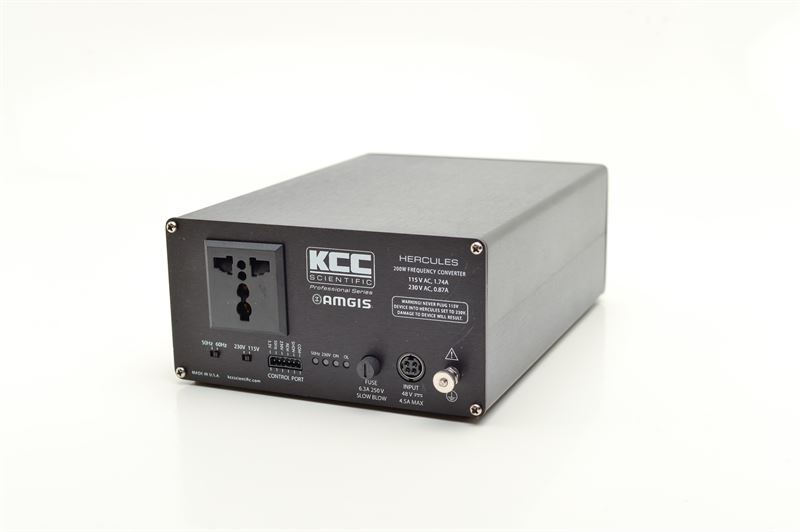To purchase frequency and voltage converters click here: https://www.kccscientific.com/frequency-converters/
Traveling, Relocating, or Working Overseas?
Everything today has gone global from the economy to satellite TV. The exception to globalization is the electrical power grid. Whether you’re moving from North America to another region or vice versa, you could be faced with the issue of mains power line differences when trying to power your electronic devices. In the new country, the voltage and frequency power standards may be very different from what you are using today.
For the most part in North America, the standard mains power is
115V AC Voltage at 60Hz Frequency
Outside of North America, the standard mains power is generally
230V AC Voltage at 50Hz Frequency

Most important, for global citizens taking their valued electronics, simply using plug adapters are NOT always enough!
Clarifying Power Converter Terminology
You are taking your valued electronics overseas, like high-end audio, perhaps a clock, a recovery boot kit, or a professional-grade salon clipper. What will you do about your plug-in devices once you arrive there? What do you need to know to convert your power? What should you buy? Do you need to buy anything at all? Let’s get started.
What are the power requirements for your electronic device?
Somewhere on your device, there is probably a tag that indicates the required power for the device. It might be in small font, and perhaps less than legible. If you cannot find it, do a quick Google search on the device’s model number and look for the specifications. A quick glance at the tag or the specifications, and you are sure to find the ratings, in a format similar to this example:
Power Requirement: 115V AC, 60Hz, 25W
This indicates the voltage, frequency, and power your device needs to operate properly. Let’s look deeper.

Every plug-in device will be AC (alternating current) rated. Voltage is what causes power to be delivered to your device.
Some devices will indicate 90-250V AC, which means that your device is “Universal” and can work on any voltage standard across the globe.
Many electronics will not be universal. If the voltage is too low your device will not activate. If the voltage is too much your device will very likely be damaged.
In general, the way the world is divided with respect to voltage is as follows:
North America: 115V AC
Rest of the World: 230V AC
Exceptions do exist. For example, Taiwan is 115V AC, as is Venezuela, Ecuador, and Colombia. So it is best to check!
Frequency
The next term in the rating is the intended Frequency for the device. Frequency is the number of times that the electric current switches polarity per second, expressed in a standard called Hertz, abbreviated Hz. On electronics with motors that turn or vibrate, the frequency will determine the speed at which they operate. Some devices will indicate 50/60Hz, which means it can operate at either 50Hz or 60Hz and perform well. However, many devices are designed for only 50Hz or only 60Hz, but not both.

As you can see from the above diagram, 50Hz, and 60Hz are very different. 60Hz alternates between polarities much faster than 50Hz, so electronics that depend on this frequency will run faster at 60Hz than at 50Hz.
The way the world is divided with respect to Frequency is as follows:
North America: 60Hz
Rest of the World: 50Hz
Again, some exceptions exist. Taiwan is 60Hz, as are Venezuela, Ecuador, and Colombia. The western half of Japan is 60Hz and the eastern half is 50Hz. So it is always prudent to check!
To check the voltage, frequency, and plug type for the country you are traveling to, click here: https://www.worldstandards.eu/electricity/plug-voltage-by-country
Power
The last term in the rating is the power the device requires to do its job, expressed in Watts. When you go to select a power converter, you will need to know this since the power converter must be able to deliver this much power or more. If the converter does not have a rating greater than this number, then it will not reliably operate your prized device. For instance, your hair clippers require 30 watts of power. You will need a power converter that provides at least 30 watts; perhaps 40 watts or more.

Plug Adapter, Transformer or Frequency Converter?
Plug Adapters
These enable you to plug into an outlet with a different shape or a different set of prongs. That’s all they do, and no more.
If the country you are traveling to has the same voltage and frequency standard as the devices you own, but the shape of the plug is different, then a plug adapter may work. An example is traveling from your home country in the UK to most European countries, where the plug style in the UK is BS1363 and the standard in Europe is the “Europlug” or Schuko. Here, a plug adapter is completely appropriate since both locations utilize the same mains power standard of 230V AC at 50Hz. But, traveling from the USA to the UK will require more than a plug adapter, since the mains power standard in the USA is 115V AC at 60Hz vs. 230V AC at 50Hz in the UK. And, pay attention–some devices will ALSO require frequency conversion since the USA standard is 60Hz whereas the UK standard is 50Hz.
Travel Adapters, Transformers or Voltage Converters
Thus, when the voltage in your home country (and that needed to operate your devices) differs from the voltage where you are planning to travel or relocate, then plug adapters are not enough. When you are moving from North America, your 115V AC electric devices can be severely damaged by the higher 230V AC mains power in other countries. If you are moving to North America, your 230V AC hair dryer or curling iron simply won’t operate on the lower 115V AC voltage. You need a transformer to convert the voltage coming from the outlet from 115V to 230V AC or from 230V to 115V AC depending on which way you are traveling across the globe and what voltage your electrical device requires.
For the most part, personal items that heat, like curling irons and hair dryers can be powered by converting only voltage with the use of transformers or voltage converters. But be careful. Curling irons and hair dryers consume a GREAT DEAL of power, and it is very challenging to find a reliable voltage converter or transformer that will perform without overheating these particular items. Some curling irons or hair dryers may be universal and have switches for the selection of 115V or 230V AC, often they don’t. The good news is that most brands of curling irons and hair dryers are readily for sale, with the proper voltage, across the globe. You can store your home-based curling irons or hair dryers for when you are back in your native country.
Summary: Transformers Convert Voltage Only
115V AC to 230V AC
or
230V AC to 115V AC.
But they leave frequency unchanged!
50 60 Hz Frequency and 230 115V AC Voltage Power Converters
If you’ve read this far, then by now you know equipment designed to uniquely operate in one part of the world may not be compatible in another. Perhaps you may have purchased a “travel converter kit” made up of conversion plugs and maybe a budget transformer, which converts the voltage (although possibly inadequately). You now understand voltage compatibility, so you dare not plug a device designed for use in North America into an outlet in another part of the world!
You embark on your trip and think everything will be fine until you get there and plug in your hair clippers or clocks, perhaps using the little transformer in your kit. You find that your salon-grade clippers make a frightening noise, grind, and don’t work. In this case, frequency (50Hz or 60Hz) as well as the voltage difference BOTH need to be considered between countries! How were you to know you needed to convert frequency as well as voltage?
Frequency AND Voltage converters convert:
Voltage from 115V AC to 230V AC or 230V AC to 115V AC
AND ALSO
Frequency from 50Hz to 60Hz or 60Hz to 50Hz.
As a general rule, devices that have turning or vibrating motors may have frequency sensitivity. These types of appliances when used at the wrong frequency will pitch, make noise, buzz, run at the wrong speed, or have timekeeping problems. In some cases, devices with motors may malfunction as well as overheat if operated from the wrong frequency. The solution is to procure a frequency (Hz) and voltage (V) converter with the proper power (Watts). For solutions visit KCC Scientific LLC and explore their products.
So keep this simple rule in mind. For powering your valued electrical and electronic devices across the globe, it’s safest to convert both voltage AND frequency. If you have questions about powering a specific device worldwide, please feel free to contact us. Or, visit our blog for solutions to powering, audio, vintage audio, clocks and flip clocks, clippers, fans, medical equipment, industrial tools, and electronic appliances across the globe.
Visit our 50 60 hz products to explore frequency and voltage converters up to 200 watts.

Examples of Frequency and Voltage Problems
Synchronous clocks (the vast majority of mechanical electric clocks) depend critically on the mains power line frequency. In fact, the accuracy of the clock DEPENDS on the accuracy of the mains power line frequency. A 60Hz clock operated at 50Hz will lose 10 minutes per hour! That doesn’t make for a very useful clock. The converse is also true. A 50Hz clock (say, from England) operating on 60Hz mains power line will run 12 minutes fast per hour. Either way, if the mains power line frequency used to power a clock is not the frequency it was designed for, the clock will be of no use. The answer is the super high-precision frequency and voltage conversion provided by compact and affordable Chronos
Audio turntables and tape players– anything with an AC-operated synchronous motor. A turntable designed for use in Germany, for example, where the mains frequency is 50Hz, will operate too fast if brought over to the USA and powered by 60Hz mains power. The pitch will be fast by 20% which is extremely noticeable. Many people can hear differences in the pitch of 1%, and there are those who can detect changes even more subtly. So, 20% is more than just extremely noticeable–it’s virtually unusable. For demanding audio applications, most folks prefer either Thor or Hercules. But we have other products as well, for lower and higher power applications. The choice will depend on how much wattage your system needs–it’s that simple.
Hammond organs– used in professional bands will run out of tune if the frequency is not exactly 60Hz. Can you imagine how far off it would be if operated at 50Hz? Many are operated on stages constructed for a particular performance, away from a mains power line source, where portable generators are used to create the power for the stage equipment. The frequency depends on the speed of the engine driving the generator, and this will invariably drift. It drives musicians crazy.
Model railroad trains transformer designed for use in the United States typically have a 115V AC 60Hz power requirement. If the system’s train transformer is run in Europe with a step-down transformer alone (converting only voltage from 230V to 115V AC at a frequency of 50 Hz), it may not operate as intended. The transformer, when operated at the lower frequency may begin to “saturate” and when it does, it may very seriously overheat. To compensate for this, it’s often recommended that the voltage into the train transformer be lowered by perhaps 20% (to about 95V AC or so). Unfortunately, this leaves insufficient power to drive the locomotive and accessories, leading to numerous malfunctions.
If this recommendation is ignored, eventually the transformer may overheat due to operating at 50Hz instead of 60Hz. The step-down transformer alone, which only converts voltage, will be insufficient. For the above model railroad example, consider Thor for systems under 100 watts, and Hercules for systems up to 200 watts.
There are other issues to worry about when operating equipment at the wrong frequency other than the speed issue. Even small motors–and for sure many large motors–are designed to operate cool and reliably on a specific frequency. If the wrong frequency is used, the motor may overheat and burn up eventually. Since it doesn’t happen right away, we often think we need to repair the device and all will be fine. But if the same kind of motor is used as a replacement, we will burn that motor up eventually as well. We hear about this on many 120V AC, 50Hz islands such as Jamaica and Barbados where 120V AC, 60Hz appliances are often imported without regard for frequency.
The above are all great examples of where KCC Scientific voltage and frequency converters can really help. Because KCC Scientific products can provide identical power conditions available in the USA (115V AC at 60Hz), the train transformer will work exactly as if it is being used in the USA, regardless of where in the world you choose to use it. Can you imagine? It’s like having a miniature power plant in your home, business, or store, right next to your model railroad, audio, or even industrial equipment setup! Any issue with incorrect or mismatched mains vanishes when these frequency converters are used!
For more solutions visit KCC Scientific LLC and explore the products.
We make extraordinary efforts to ensure the information on this website is accurate and reliable. We are not liable for any errors, financial loss, or damages of any kind that may result from the use of, or reliance on, the information herein, and/or on this website.
Frequency Converter 60hz to 50hz.



